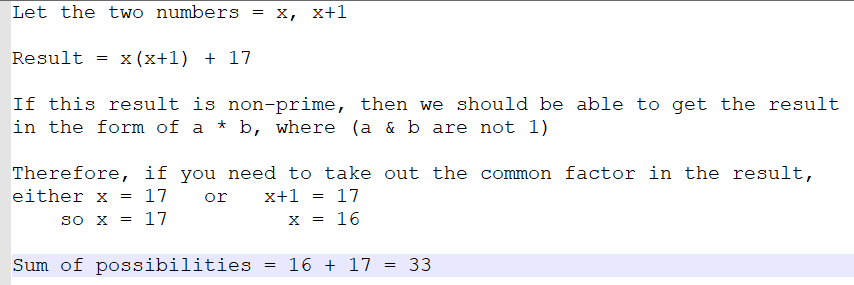Ask Singapore Homework?
Upload a photo of a Singapore homework and someone will email you the solution for free.

Question
primary 6 | Maths
One Answer Below
Anyone can contribute an answer, even non-tutors.

olympiad
The formula for the mathematical sentence now becomes:
(x) * (x+1) + 17 = n
n is the number that you get. Now you dont want this n to be prime. That means that n has to be divisible by something other than 1 or itself. n has to be a multiple of a number.
Think back to how multiplication works. If for example i say 2 × 3 = 6, that means im adding 2 three times, or three twice
(2+2+2 =6 = 3+3). This means that 6 is a multiple of 2 and 3, because it can be added from those two numbers.
Therefore when we say that n is a multiple of a number. But from the example i gave, the number has to be such that you can add a factor to get the number. So in this question, you added 17 to the product.
Therefore, n has to be a multiple of 17, and that you should be able to divide this number by 17.
Going back to the original question:
(x) * (x+1) + 17 = n
To make this sentence true, you need to divide throughout each term by 17, and still get a whole number. Going from the left, n/17 has to be a whole number. 17/17 is 1, so that is true.
Now, (x)*(x+1) / 17 has to be a whole number. Since 17 is a prime, it has to be one of the terms in the bracket. True enough, 17 can be either one of the numbers.
If 17 is x, then x+1 is 18. If 17 is x+1, then x is 16
Therefore, you now have to two smaller values of the whole number. It is 16 and 17.
Now that you know how it works, you can try working backwards to check and see that it works.
16*17+17 = 289 = 17 × 17
17*18 +17= 323 = 19 x 17
Hope it helps!
See 1 Answer





